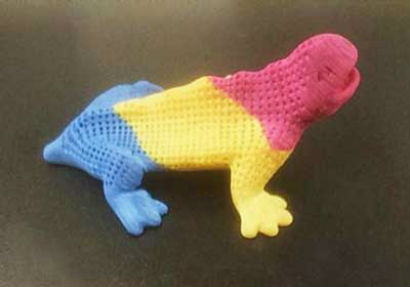|
NOVIDADES
People are exploring the use of 3D printing for wide-ranging applications, including manufacturing, medical devices, fashion and even food. But one of the most efficient forms of 3D printing suffers from a major drawback: It can only print objects that are gray or black in color. Now, researchers have tweaked the method so it can print in all of the colors of the rainbow. They report their results in the ACS journal Nano Letters ("White and Brightly Colored 3D Printing Based on Resonant Photothermal Sensitizers").  This brightly colored dragon was produced by 3D printing, using gold nanorods as photosensitizers. Image: American Chemical Society
To reduce the energy requirements of the process, researchers have added compounds called photosensitizers to the polymer powders. These materials, such as carbon nanotubes, carbon black and graphene, absorb light much more strongly than the polymers and transfer heat to them, enabling the use of cheaper, lower-power lasers. However, the carbon-based photosensitizers can only produce printed objects that are gray or black. Gerasimos Konstantatos, Romain Quidant and their coworkers at The Institute of Photonic Sciences (IFCO) wanted to find a photosensitizer that would enable color printing by the SLS method. The researchers designed gold nanorods to strongly absorb in the near-infrared region of the spectrum while being almost transparent to visible light. They coated them with silica and then mixed them with polyamide powders to print 3D objects. They found that the gold nanorods were much better at converting light from the laser to heat than carbon black, the industry standard. Also, the new photosensitizers could produce much whiter and - when mixed with dyes - brightly colored 3D objects. Importantly, the materials are cost-effective for large-scale production. The researchers have filed several patent applications related to the new technology. American Chemical Society. Posted: Aug 01, 2018. |
|||||||||||||||||||||||||